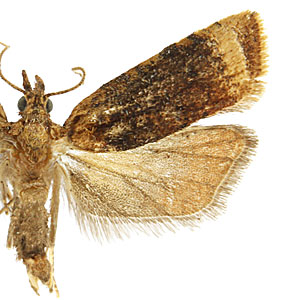Overview

The genus Platynota contains approximately 30 species. The highest species diversity is in the Neotropics, although a few species are described from the northern U.S. and Canada. Adults are sexually dimorphic and wing pattern varies throughout the genus. The forewings of many males are dark brown basally and golden or yellowish brown apically. Female forewings are usually uniformly brown or yellowish brown with dark brown markings. Males have a forewing costal fold. Male genitalia are characterized by a long thin uncus, long, fingerlike socii, and elongate subrectangular valvae. Female genitalia are characterized by a bandlike sterigma and a variably-shaped signum in some species. Labial palpi are elongate in most species.
The three species treated here, P. flavedana, P. idaeusalis, and P. stultana, are pests of various crops, including apple, citrus, grape, peach, pepper, rose, and strawberry. Larvae are highly polyphagous and some species, such as P. stultana, have been recorded feeding on plants in more than 20 families. As these three species are likely the most common Platynota in the continental U.S., they are presented here as non-targets potentially encountered during domestic surveys. For photos of additional non-targets not covered here, visit the Moth Photographers Group link below.
Larvae of Platynota are commonly intercepted at U.S. ports of entry on peppers (Capsicum) from the Caribbean and Mexico, and apple (Malus), basil (Ocimum), rose (Rosa), and Rubus from Cental and South America. Larvae are difficult to identity using only morphology, and most identifications are based on a host/origin association. Larvae of Platynota may be confused with those of Argyrotaenia, other Archipini, or other Sparganothini.
Non-target species
Platynota flavedana
Platynota idaeusalis
Platynota stultana
Links

The following external links require an internet connection. The authors, CSU, CDFA, and USDA/APHIS/PPQ/CPHST are not responsible for the availability or content of these external sites:
Moth Photographers Group - Sparganothini
References

AliNiazee, M. T. and E. M. Stafford. 1972. Notes on the biology, ecology, and damage of Platynota stultana on grapes. Journal of Economic Entomology. 65: 1042-1044.
Chapman, P. J. and S. E. Lienk. 1971. Tortricid fauna of apple in New York (Lepidoptera: Tortricidae); including an account of apple's occurrence in the state, especially as a naturalized plant. Spec. Publ. Geneva, NY: New York State Agricultural Experiment Station. 122 pp.
Hogmire, H. W. and A. J. Howitt. 1979. The bionomics of the tufted apple budmoth, Platynota idaeusalis in Michigan. Annals of the Entomological Society of America. 72: 121-126.
Powell, J. A. 1983. Expanding geographical and ecological range of Platynota stultana in California (Lepidoptera: Tortricidae). Pan-Pacific Entomologist. 59: 233-239.
Wilde, G. and M. Semel. 1966. The life history of Platynota flavedana, a leaf roller of strawberry. Journal of Economic Entomology. 59: 1037-1041.

